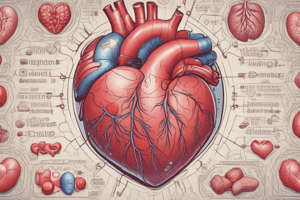Podcast
Questions and Answers
Which of the following is NOT a typical symptom of IHD?
Which of the following is NOT a typical symptom of IHD?
- Sharp pain in the back (correct)
- Sensation of pressure or squeezing in the anterior chest area
- Radiating pain to the neck, jaw, or arm
- Dyspnea or nausea
Which of the following is a major risk factor for IHD?
Which of the following is a major risk factor for IHD?
- Regular exercise routine
- Hyperlipidemia with HDL > 60 mg/dL
- Hypertension with BP > 130/80 mmHg (correct)
- Hypotension
Which type of angina is characterized by pain that occurs at rest and is prolonged and unrelieved by sublingual nitroglycerin?
Which type of angina is characterized by pain that occurs at rest and is prolonged and unrelieved by sublingual nitroglycerin?
- Stable Angina
- Unstable Angina
- Prinzmetal's Angina
- Acute Coronary Syndrome (ACS) (correct)
What is the primary strategy for delaying IHD progression and preventing IHD-related events?
What is the primary strategy for delaying IHD progression and preventing IHD-related events?
Which of the following is a symptom of stable angina?
Which of the following is a symptom of stable angina?
What is the typical duration of symptom relief for stable angina after rest or sublingual nitroglycerin?
What is the typical duration of symptom relief for stable angina after rest or sublingual nitroglycerin?
What is a characteristic of stable angina?
What is a characteristic of stable angina?
Which of the following is NOT a risk factor for IHD?
Which of the following is NOT a risk factor for IHD?
What is the preferred marker for myocardial injury?
What is the preferred marker for myocardial injury?
What is the significance of elevated cardiac troponins?
What is the significance of elevated cardiac troponins?
What is the time frame for peak levels of cardiac troponins?
What is the time frame for peak levels of cardiac troponins?
What is the purpose of an electrocardiogram (ECG) in diagnosis?
What is the purpose of an electrocardiogram (ECG) in diagnosis?
What is the significance of a normal ECG?
What is the significance of a normal ECG?
What is the purpose of CK-MB in diagnosis?
What is the purpose of CK-MB in diagnosis?
What is the primary cause of coronary artery narrowing and reductions in coronary blood flow in chronic stable angina?
What is the primary cause of coronary artery narrowing and reductions in coronary blood flow in chronic stable angina?
Which type of angina is also known as 'effort angina'?
Which type of angina is also known as 'effort angina'?
What is the typical presentation of stable angina?
What is the typical presentation of stable angina?
What is the underlying pathology of chronic stable angina?
What is the underlying pathology of chronic stable angina?
What is the effect of rest on symptoms of stable angina?
What is the effect of rest on symptoms of stable angina?
What is the characteristic of chronic stable angina?
What is the characteristic of chronic stable angina?
What is the primary difference between chronic stable angina and unstable angina?
What is the primary difference between chronic stable angina and unstable angina?
What is the characteristic of anginal episodes in chronic stable angina?
What is the characteristic of anginal episodes in chronic stable angina?
Flashcards are hidden until you start studying
Study Notes
IHD Risk Factors
- Age: > 45 years for males, > 55 years for females
- Family history: premature IHD in males < 55 years, females < 65 years
- Hypertension: BP > 130/80 or on anti-hypertensive therapy
- Smoking
- Hyperlipidemia: HDL < 40 mg/dL (subtract one risk factor if > 60 mg/dL)
- Diabetes
- Obesity: BMI > 30 kg/m2
- Sedentary lifestyle
- CVD (cardiovascular disease)
- PAD (peripheral arterial disease)
IHD Symptoms
- Typical pain: pressure, heaviness, or squeezing in the anterior chest area
- May radiate to the neck, jaw, shoulder, back, or arm
- May be accompanied by dyspnea, nausea, vomiting, or diaphoresis
- Sharp pain is not a typical symptom of IHD
- Symptoms of stable angina are often provoked by exertion, emotional stress, exposure to cold temperatures, and heavy meals
- Symptoms of stable angina are relieved within minutes by rest or sublingual nitroglycerin
- Symptoms of ACS: pain occurs at rest (without provocation) and is prolonged and unrelieved by sublingual nitroglycerin
Diagnosis and Evaluation
- A thorough medical history, physical exam, and laboratory analysis are necessary to ascertain cardiovascular risk factors
- Laboratory analyses should assess for glycemic control, fasting lipids, hemoglobin, and organ function
- Electrocardiogram (ECG): a 12-lead ECG recorded during rest is often normal in patients with chronic stable angina
- Cardiac troponins T and I are the preferred markers for myocardial injury
- Serum troponin levels increase within 3-12 hours from the onset of chest pain, peak at 24-48 hours, and return to baseline over 5-14 days
- CK-MB levels increase within 3-12 hours of onset of chest pain, reach peak values within 24 hours, and return to baseline after 48-72 hours
Angina Types
- Stable Angina (also known as "effort angina")
- Unstable Angina
- Prinzmetal's (Variant) Angina
- Chronic Stable Angina (CSA): also known as "effort angina", refers to the classic type of angina related to myocardial ischemia
- Symptoms of CSA typically decline several minutes after activity and happen again when activity resumes
- Other recognized precipitants of stable angina include cold weather, heavy meals, and emotional stress
Studying That Suits You
Use AI to generate personalized quizzes and flashcards to suit your learning preferences.




